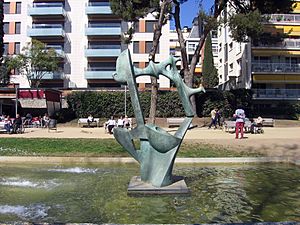Ángel Ferrant facts for kids
Quick facts for kids
Ángel Ferrant
|
|
|---|---|
 |
|
| Born | 1 December 1890 Barcelonès, Spain
|
| Died | 1961 Madrid, Spain
|
| Nationality | Spanish |
| Known for | Sculpture |
Ángel Ferrant Vázquez (born in Madrid in 1890, died in 1961) was a Spanish sculptor. He was known for his avant-garde art, which means he liked to try new and experimental ideas. His work often included styles like surrealism and kinetic art. Kinetic art is art that moves!
Contents
Ángel Ferrant's Life and Art
Ángel Ferrant was the son of a painter named Alejandro Ferrant. He studied sculpture at the Escuela de Artes y Oficios in Madrid. He also attended the Real Academia de Bellas Artes de San Fernando and learned from sculptor Aniceto Marinas.
His early sculptures were in a style called academic realism. This means they looked very real and traditional. One of his important early works is La cuesta de la vida (The Hill of Life). This sculpture is now in the Museo del Prado. He won a special medal for it in 1910.
In 1913, Ángel traveled to Paris, France. There, he learned about futurism. Futurism was an art movement that focused on speed, technology, and the future. Even though he wasn't a strict futurist, these new ideas helped his sculptures change and grow.
Later, Ángel became a teacher. He taught sculpture and casting. First, he worked at the Escuela de Artes y Oficios in A Coruña for two years. Then, in 1920, he moved to the Escola de la Llotja in Barcelona. He stayed there until 1934. After that, he became a permanent teacher in Madrid.
Discovering New Art Styles
While in Barcelona, Ángel Ferrant started exploring new art movements. He became interested in noucentisme and other avant-garde styles. You can see this new influence in his work La escolar (The Schoolgirl). He won first prize for this sculpture in 1926.
In 1927, he received a scholarship to travel to Vienna. He went there to learn new ways of teaching sculpture. During his time in Barcelona, he showed his art in many galleries. He also joined different art groups. One important group was Amigos de las Artes Nuevas (ADLAN). This group was connected to surrealism. Surrealism is an art style that uses dream-like images and ideas. Ángel Ferrant was a very active member of ADLAN.
In 1936, he took part in the Exposición Logicofobista in Barcelona. This was another surrealist art show. Around this time, Ferrant began to experiment with everyday objects in his art. This was part of the "objet trouvé" (found object) idea. He also met Alexander Calder, a famous artist known for his moving sculptures.
Protecting Art During the Civil War
When the Spanish Civil War began in 1936, Ángel Ferrant signed a statement against fascism. In 1937, he joined the Committee for the Seizure, Protection and Rescue of the Artistic Treasure. This committee worked to save important artworks during the war. His brother, Alejandro Ferrant, was also part of this group.
Ángel helped organize photos of all the artworks the committee was saving. For a short time, he was also the director of the Modern Art Museum. He also led the Artistic Treasure Section of a larger board. These were difficult times, and the museum often stayed closed.
Ángel was also in charge of tours to collect and protect art in different towns. In 1938, he became the president of the Artistic Treasure Board in Madrid. He sometimes disagreed with government officials about moving artworks. He even tried to resign because he didn't want a famous painting, The Descent from the Cross by Rogier van der Weyden, to be moved.
After the War: New Artistic Paths
After the war, Ángel Ferrant had to explain his actions during the conflict. He wrote a statement explaining how he helped protect art. A report from the Servicio de Defensa del Patrimonio Artístico Nacional also confirmed his role in saving artworks in Madrid.
Once these issues were resolved, he went back to creating art. In 1939, he made a series of terracotta (clay) sculptures called Tauromaquia (Bullfighting). These works showed him returning to a more realistic style, but with his own unique touch.
In 1943, architects asked him to create sculptures for the Teatro Albéniz in Madrid. He carved eleven wooden statues. These statues were special because they could move! With a simple crank and a small motor, their arms, legs, and bodies would move. They looked like they were playing guitar or fanning themselves. These moving statues were on the theater's front until 1983. Now, you can see them inside the theater's lobby.
Ferrant also continued to work with "objetos hallados" (found objects). He would use shells, stones, and sticks to create new art pieces. These were not meant to be useful, but to express ideas.
In 1948, he met German artist Mathias Goeritz. They worked together on a book called Figuras del mar (Figures of the Sea). This book had Ferrant's drawings and texts in German. In 1949, he showed his "móviles" (mobiles), which were moving sculptures similar to those by Alexander Calder. In 1960, Ángel Ferrant won a special sculpture award at the XXX Bienal of Valencia.
See also
 In Spanish: Ángel Ferrant para niños
In Spanish: Ángel Ferrant para niños

